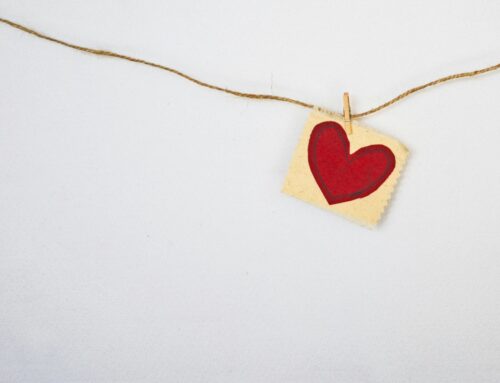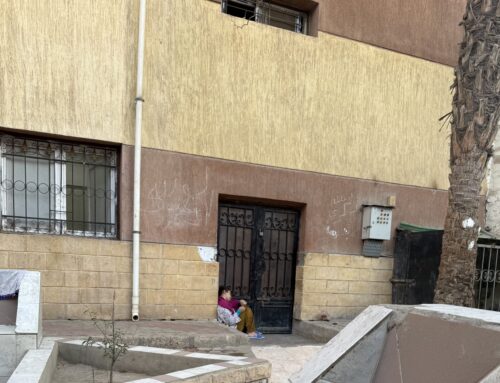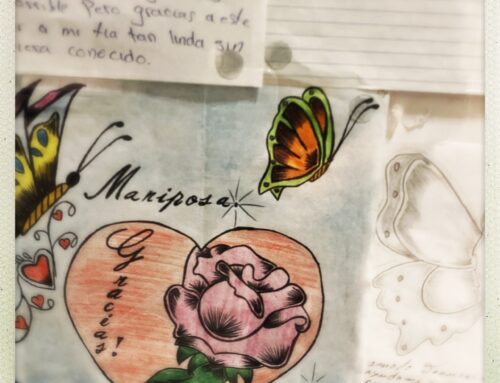
A soldier holds a portrait of Kostya at the funeral. Courtesy of Kostya’s family.
It was freezing as we carried his coffin to its final resting place. I wondered how they would dig a grave in the frozen ground, and whether the earth would cover him gently. Tanya, his sister and my closest friend from middle school, walked just behind the coffin. I wanted to hold her hand and never let go.
Dozens of hand-held flares lit the path, their glow reflected in the solemn faces of his brothers-in-arms—a tradition at war funerals in Ukraine. He will forever remain 22, sealed in a closed casket, killed in the fight for his country.
Kostya was not the first person I lost in this war, but he was the first friend I had watched grow up who was killed. I vividly remember coming home from school with Tanya and watching him race around the room, as if chased by invisible playmates only he could see. He was unstoppable, running in circles around us, his laughter filling the space. The room suddenly felt too small to contain all that energy.
We laughed at him and with him, this seven-year-old ball of light who could lift everyone’s spirits. Later, he joined us at school, and I watched him grow into someone who was always there for others, offering a kind, cheerful word to anyone who needed his warmth.
After school, our lives took different paths but I remained in touch with his sister. A decade later, amid the Russian full-scale invasion of Ukraine, I met Kostya again—not just as a friend, but as an interlocutor, as I interviewed soldiers about their experiences in combat. I still smile when I think back to that moment as I ran to hug him, startled by how tall he had grown. Yet, to me, he was still that little boy, full of mischief and an unshakable spark.
“How is Donbas?” he asked, already knowing from our brief conversations before the interview that I had been traveling back and forth to the East.
I let out a sigh, searching for the right words.
“Yeah, it’s the kind of place you never want to return to—but one you can never forget,” he said, as if reading my mind. Then, with the dark humor so common among soldiers, he added, “Well, thank you for making time to talk to someone who’s still alive.”
He was joking, as many soldiers do when I tell them my research focuses on death work: tracing the pathways of fallen Ukrainian soldiers and those tasked with finding, identifying, and bringing them home.
If only I had known then that just a month later, his sister would text me to say Kostya had gone Missing in Action, presumably killed. I don’t know what I would have done differently. But I do know I would have hugged him a thousand times more. Or recorded a longer interview, hours upon hours, so I could listen to his voice for years to come.
In war, death becomes an everyday companion. The more soldiers you know, the closer it lingers—breathing down your neck, pressing in with every handshake after an interview. Every message from them could be their last. Every photo they post could become a memorial, a portrait carried to the funeral.
I push those thoughts aside and lean into dark humor, too: “We’re all dead men walking. You can’t kill someone who’s already dead!” And so, we let death rest on our shoulders, not as something to fear, but as something inevitable.
Missing in Action is not the same as being dead. As long as his body remains unfound—never transported to the morgue, never matched with DNA, never identified and returned to his family—there is no certainty, no finality. In expert terms, he cannot be declared dead. But in human terms, he exists in a cruel limbo, suspended between not yet gone and absence.
Kostya’s brothers-in-arms told his sister what had happened: he had broken cover to reload an artillery gun, determined to halt the invaders’ advance. His shot found its mark. But just as he sprinted back toward safety, a drone struck. The explosion tore into his legs, shattering flesh and bone. They fought to save him, hands pressing down on tourniquets, willing the bleeding to stop. But the shelling was relentless. There was no way to carry him, no chance to drag him to safety. And so, they were forced to do what every soldier fears most. They left him behind.
Kostya never made it back to their positions. He might have been captured, held somewhere on the Russian side. Or perhaps his body still lies there, untouched, waiting for someone to find him.
I’ve spoken with Tanya almost every day since May 2024, when she received the news. By the time I arrived in Ukraine that summer, we still didn’t know if his body had been recovered. His unit had vowed to do everything—anything, and beyond—to retrieve him from the battlefield. But to do that, someone else would have to risk their life. And all too often, in the effort to evacuate the wounded or the dead, another soldier pays the price.
His sister, gripped by a fear no one should have to endure, worried that his body would decay beyond recognition. She asked me for details. What would happen to him in a month? In three months? In half a year?
For the first time, I found myself utterly speechless, unable to put into words what I had learned through my fieldwork. Suddenly, death was no longer something I could analyze. It was something I wanted to forget. The bodies I had seen in the morgue, the faces of grieving relatives arriving to identify them, the knowledge I had spent years accumulating—all of it felt lodged in my throat, jagged and unbearable, as if I were chewing on shattered glass.
Tanya told me she could handle anything, that she just wanted to know.
Her daughter was sleeping peacefully in the backseat, but I couldn’t shake the worry that somehow she could still hear us. So, we stepped outside for a smoke.
“Did you tell her about Kostya?” I asked.
“Yes,” she said softly. “She just thinks he’s far away, up in the clouds.”
Then I told her the truth, keeping it as bare as possible, leaving out as many details as I could, to protect her, at least, from engraving those horrifying images into her memory.
I said, “It depends on the weather. It’s been warm these last few months, so the body would have decomposed faster. I don’t think visual recognition would be possible, not as Kostya, not as you remember him. Maybe through his clothes. But his face, his expressions—everything that made him look like himself—would be unrecognizable.”
I would return to those words again and again, wondering if I could have made them hurt less. But no matter how many times I replayed the moment, the truth remained the same. There was no gentle way to say it.
Tanya took it in with quiet stoicism, her face unreadable. She asked for another cigarette, and we smoked in silence. There were no words left, just the weight of knowing, hanging heavy between us.
I left Ukraine at the end of summer and returned only in December. By then, eight months had passed since the day we first heard that Kostya was Missing in Action. Eight months of waiting, of hoping, of dreading.
His unit stayed in touch with Tanya throughout, offering not just the story of his last day but glimpses of the life he had lived. She learned things she hadn’t known—like the fact that Kostya had a girlfriend, someone he had not yet introduced to his family. And so, in the cruel limbo of uncertainty, this girl met his family for the first time, not through celebration or laughter, but through the shared weight of waiting.
Together, they braced for the worst while still clinging to the fragile hope that they were wrong.
On December 6th, I received a message from Tanya.
They had heard back. Kostya had been identified.
A week later, they would lay him to rest.
On the day of the funeral, I met Tanya and Kostya’s girlfriend at the morgue. Only his father went inside. The rest of us waited in silence, a dozen cars filled with people, all ready to join the procession that would carry Kostya’s body through the city. First, to the place where he had grown up. Then, to the graveyard. It had been a long time since I cried. Maybe a year by then. That morning, Tanya, too, remained composed, holding herself together with the same quiet strength she had carried for months. But then her phone rang.
Her father’s voice on the other end: “Follow the minibus.”
The doors at the back of the morgue opened, and the vehicle carrying Kostya’s body rolled out.
Tanya let out a small, broken scream. It was barely more than a gasp, yet it cut through the air like a knife. “This is Kostya!”
The words shattered whatever fragile hold we had on ourselves. One by one, the car filled with sobs: her husband, Kostya’s girlfriend, me… No one spoke, no one tried to hold it in anymore. There was nothing left to do but grieve, together, as the procession moved forward.
We stopped at the Independence Monument in Maidan Square. One by one, everyone stepped out of their cars, kneeling in front of the monument to honor Kostya’s service.
In this place of history, where Ukraine had once risen in defiance, another sacrifice was now being mourned.
As I knelt, memories of my high-school self flashed before my eyes. The Maidan Revolution, 2014. Protesting, hands gripping Molotov cocktails. The sting of smoke in my lungs. The first wounded. The first dead. The weight of it all, the cost of fighting for something greater. And now, a decade later, we were here again, kneeling not in protest, but in grief.
The megaphone on one of the cars broke through the silence, its voice carrying over the square, announcing to every passerby: Today, we remember Kostya. Brother, Friend, Warrior.
Strangers who happened upon us paused, watching. And then, one by one, they knelt too—old and young, side by side, forming quiet lines along the road. Some placed their hands over their hearts. Some began to cry. Others stopped their cars, stepping out in silent respect.
For a moment, the whole city seemed to bow, as if it, too, was mourning Kostya.
Outside his home, in the neighborhood where he grew up, more people gathered. Faces from my school years—teachers, classmates, their parents—people I hadn’t seen in years. This is not how I ever imagined reuniting with them.
At the graveyard, we came forward one by one to pay our respects. His grandmother collapsed against the coffin, her frail hands gripping the wood as if she could hold him back from leaving. “My dearest Kostya, how is this possible? I raised you!” she wept, her voice breaking. Someone gently helped her to the side. Her cries lingered in the air.
Dozens—then dozens more—stepped forward, each carrying their own sorrow, their own memories of Kostya. When my turn came, I knelt before him. My hand rested on the flag draped over his coffin, the fabric stiff beneath my fingers.
“We will continue your fight,” I whispered. “No matter what.”
And for a moment, it felt like a vow etched into the wind, carried beyond the grave.
Kostya will forever remain 22, sealed in a closed casket, killed in the fight for his country.
Hanna Dosenko is a PhD candidate in the Anthropology Department at the University of California, Irvine. She traces pathways of fallen Ukrainian soldiers, and the military personnel, forensic experts, and volunteers who recover and identify them, showing how this work reshapes ties between the living and the dead. Writing at the seam of war and loss, she explores what it means to live alongside death, and to make kin across its threshold.
Cite as: Dosenko, Hanna. 2025. “For Kostya: Brother, Friend, Warrior.” In “Anthropology that Breaks Your Heart: Loss and Found,” edited by Salwa Tareen, Magdalena Zegarra Chiappori, and Hosanna Fukuzawa, American Ethnologist website, 24 November. [https://americanethnologist.org/online-content/for-kostya-brother-friend-warrior-by-hanna-dosenko/]
The American Ethnological Society Digital Content Editor is Kathryn E. Goldfarb (kathryn.goldfarb@colorado.edu).




